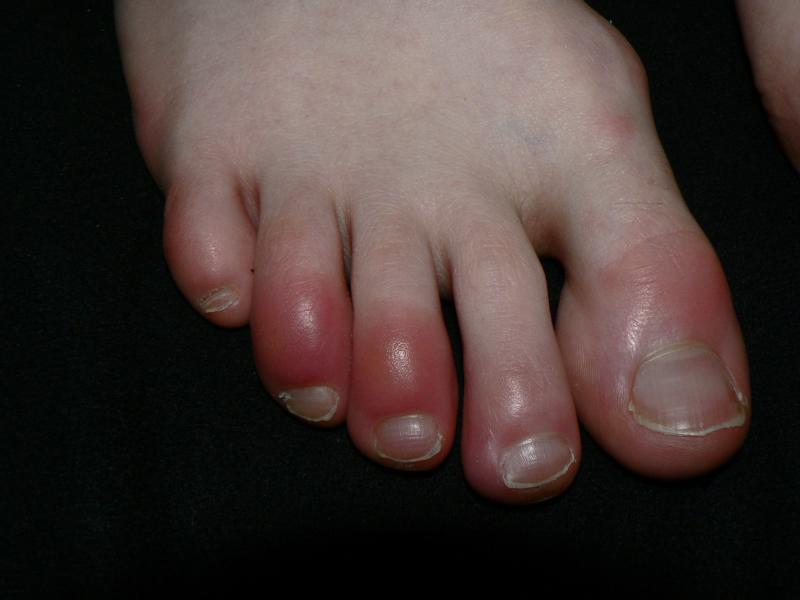Watch Out for Worrisome Winter Foot Conditions
Posted by Hanson Lee on

So far this winter, we’ve tried to give you a good overview of the many things to keep in mind in regards to your feet: the right winter shoes, winter fitness options, winter running, cold weather nutrition and maintaining healthy winter feet. But sometimes an unfortunate foot health issue can sneak in despite the usual precautions.
This risk is heightened as a growing number of people participate in the wide variety of winter sports, from skiing and snowboarding to ice hockey and figure skating. Avoid spending the rest of winter off your feet by learning about these conditions and how to prevent and treat them.
Chilblains
More common in people with poor circulation, chilblains (pictured above) occur when the skin is exposed to cold humid and then is introduced quickly to a warm environment. The cold air first constricts the small blood vessels in the skin; if the skin gets hot too quickly, the blood vessels cannot react properly in time. Blood then leaks into the tissue, resulting in itchy, red and, at times swollen, spots on the skin. If aggravated, they can become ulcers or cause infections, as the skin dries out and cracks.
Chilblains are often found on the toes and, more specifically, on bunions and calluses, where there is more pressure on the foot. You can lessen your risk of chilblains by keeping your feet warm at all times and by avoiding the use of direct heat. Let your feet warm up slowly so that your circulation can respond to the change in temperature in a healthy way.
If you think you have a chilblain, you can use an anti-itch lotion but, like doctors always say, don’t give in to the itch. Scratching will irritate the skin even more. If you suffer from diabetes or have circulatory issues, see your podiatrist to minimize risks.
Raynaud's Phenomenon
Named for a French doctor, this disorder sounds more like an astronomical event than a medical condition affecting blood vessels (or at least it does to us). Like we saw above, very cold temperatures cause small blood vessels to tighten, limiting circulation towards the extremities, which are already at a disadvantage for being so far from the body’s core.
Raynaud’s presents when this lack of blood supply and oxygen to the feet causes pain, blistering and discoloration. Chilblains may also appear. It affects between 3-5% of the population, and is more common in young women.
The condition is aggravated by cold and sudden changes in temperature. If you will be spending an extended period of time outdoors keep extremities covered and be aware of the look and feel of your skin. If your skin is turning white, get indoors and warm the area slowly until it returns to normal color. Avoid smoking and caffeine, which both affect blood vessels negatively.
Skier’s Toe
If you look down at your feet and see a black toenail looking back up at you, you might have skier’s toe. The dark color you see is caused by bleeding under the nail (known medically as a “subungual hematoma”), and the painful pulsing you feel is due to the pressure of the blood against your nail.
One-time trauma or repetitive use of too-tight shoes (especially ski boots, hence the name) can cause this condition. So it is important that your winter sports footwear allows you proper roominess in the toe box. Make sure your socks fit tightly all around your foot – we don’t want anything putting additional pressure inside the front of your boots.
If you have a black nail, you should speak to a podiatrist immediately. The sooner you get it looked at, the easier it will be to treat by relieving the pressure behind the nail.
Morton’s Neuroma
Like skier’s toe, Morton’s neuromas are caused by too-tight footwear, which squeezes the tissue and bones against nerves. The result is pinched nerves that cause burning, numbness and tingling. This painful “electric toe” is most common around the third toe, but can happen in other parts of the foot.
Your feet get wider as you age, so make sure to check your foot size (and width) every winter. If you think you already have a neuroma, a visit to the podiatrist is needed. Nerves can suffer permanent damage if not treated correctly with padding, different shoes, orthotics and/or medications to reduce the inflammation.
Blisters
Well-fitting and quality-made winter shoes help keep your feet free of these pesky skins bubbles. But friction reigns from time to time, and repeated rubbing may cause blisters to develop, especially if you’re breaking in new shoes (though, if you’re getting shoes fitted properly by a professional, you shouldn’t really have to “break them in” to begin with).
If your shoes are causing you blisters, it’s a sign that you shouldn’t be wearing them. It’s not worth the pain. You can also try inserting some extra padding between your skin and the problem area. Resist the urge to pop the blister yourself. Clean it with soap and water, and let it heal on its own. If it opens, put a topical antiseptic to avoid infection (and a trip to the podiatric clinic).
***
Wondering what shoes and socks would be best for your feet this winter? Do you have existing foot health conditions that require you to take extra precautions, especially during extreme winter weather? Stop by a SHOES-n-FEET store today to speak to a Certified Shoe Fitter or email Ask the Shoe Fitter!
